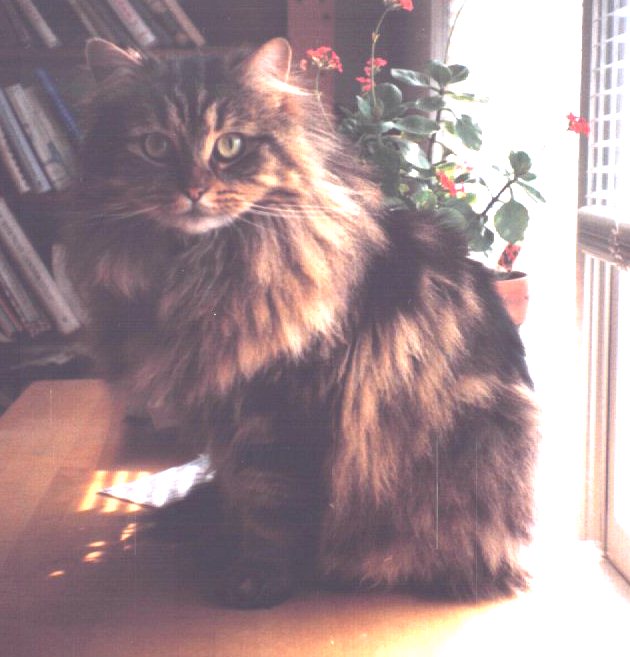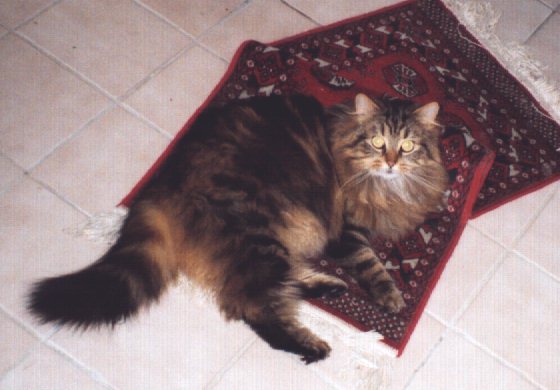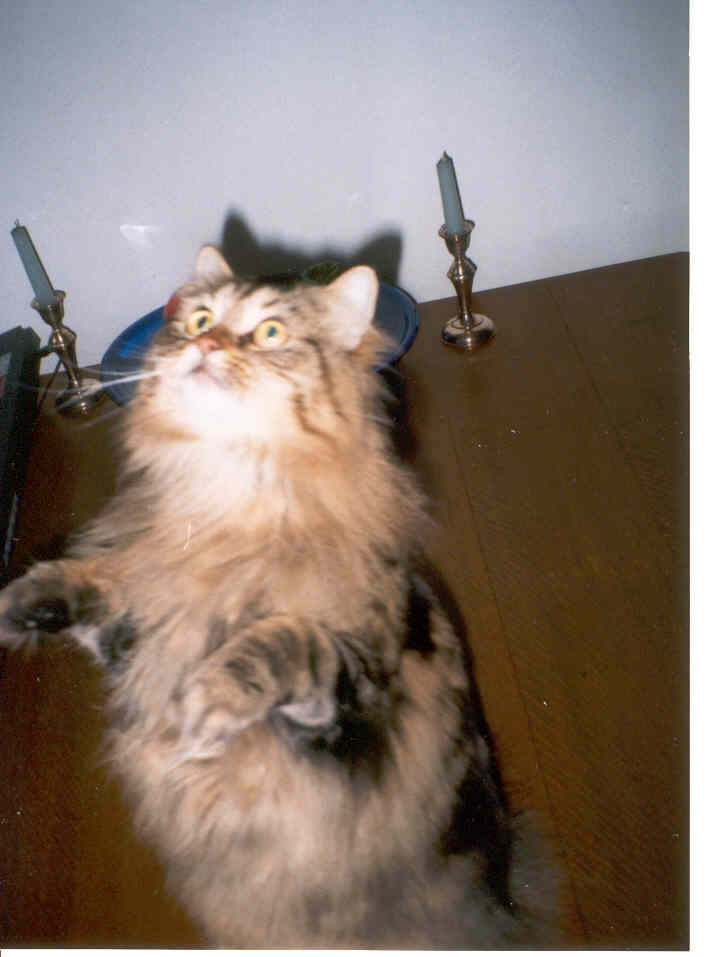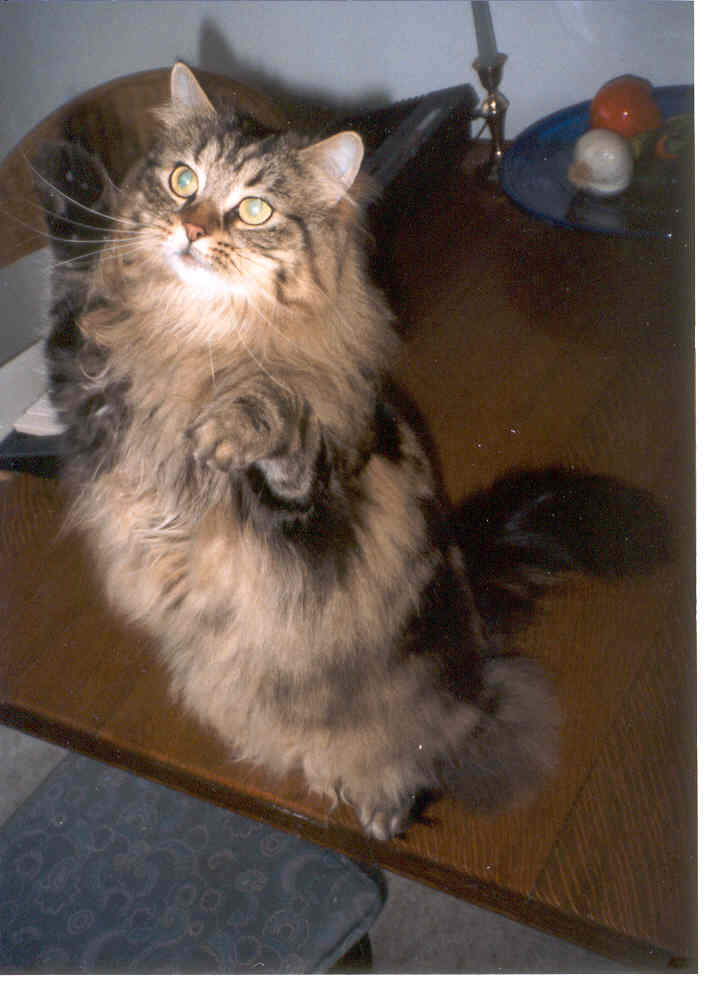![[IMAGE]](CLEVER CATS_files/givpaw3.jpg)
Behavior Training Your Cat- Your cat will
learn proper behavior once he knows what you expect from him. As Elizabeth
Randolph explains in her book, How to Be Your Cat's Best Friend your cat
will learn through "patient, repeated demonstration, reward and frequent vocal
reinforcement".
Teaching NOT to Scratch or "Soft Paw"
is one of the first things I taught my cat. During quiet quality time
together when your cat is on your lap and starts to knead you and his claws
begin to dig into your skin is THE BEST time to teach your cat "Soft Paw". To do
this simply take your finger and gently stroke over your cat's paw over and over
until the claws retract while gently saying in a soothing voice "Soft Paw_____,
that's Soft Paw".
You may need to repeat this several times over a period
of weeks or months but your cat WILL LEARN not to scratch. I never used a food
reward when teaching "Soft Paw". Unlike with trick training, in behavior
training your cat you are showing him what you expect from him on a regular
basis. Gentle stroking and the sound of your voice gently telling him how good
he he is when he does "Soft Paw" should be reward enough.
For instance,
after telling him to "Use Soft Paws ____", as he retracts his claws say
Good____, that's a Good Soft Paw_____!
After teaching my cat "Soft Paw"
he never scratched me while kneading me or any other time again except for one
time when I was playing with him over by his scratching post and he was very
excited and I got my hand in the way. I of course, was the one TOTALLY at fault
and took 100% of the blame as I should have!
Behavior Training
Guidelines:
1) Handle your cat gently! Do not rough house with your
cat.
2) When playing with your cat use a toy or object instead of your hands
to avoid getting accidently scratched.
3) If your cat scratches you
accidently while playing, it is not your cat's fault but YOUR fault for getting
in his way. Shouting at your cat to try to discipline him for this completely
normal behavior accomplishes nothing and just confuses your cat.
4) Using a clicker to click when your cat has successfully
performed a trick can also be done but is completely optional. In fact, I think
praising your voice is much nicer and less obnoxious sounding than those
clickers which are nothing more than New Year's Eve party makers.
5) Have a
good reward for your cat and make sure you conduct trainings before your cats
meal time (not afterwards) when he or she will appreciate the reward even
more.
Easy Tricks To Teach Your Cat- "STAY" is the first trick (and the
easiest trick) Rudy learned. To teach your cat to "stay", take your cat in a
private room bringing a few healthy treats like some chicken or turkey. Make
sure the training session is done before meal time on an empty stomach so your
cat will have an edge to his appetite.
Put your cat on a table (I used my
kitchen table) or a bed or a platform where you and he will be almost eye to
eye.
After you put him on the platform and he begins to wander off, in a
clear controlled voice, call out his his name followed by :"hssssstay" and make
a stop sign with your hand palm facing your cat's face about one foot
away.
Your cat should pull back and freeze. Immediately after say "Good
_____" and give him one bite worth of the treat. After he finishes the treat,
repeat the trick again. Let him begin to get distracted and tell him to
"ssstay".
Emphasis on the "S" simulates the hissing sound cats make to
each other and they respond by stopping and freezing and staying where they
are...if you've ever noticed your cat in a stand off with another cat, you've
seen this. By learning how cats communicate with each other and incorporating
this language into training your cat, you will not only soon have a very clever
cat but a much deeper more profound relationship with your cat. Review the trick
with your cat in 2 or three 5 minute sessions per day. The next
trick...
"COME" After you've taught "Stay", "Come"
is the next easiest to teach. By now your cat knows that by learning the command
he will get yummy treats so he is eager to learn! Your cat already may know come
but until now may come only when you call and he feels like coming. By
learning the "come" command and reviewing it with him, before long he will come
when you call and will NOT even need to be rewarded.
If your cat is an
indoor/outdoor cat, learning to "come" when called can be very useful when it is
time for your cat to come inside. Even though your cat may love being outside,
if you let him out before meals for a 1/2 hour or so and then call out his name
and "come" or "here____" "come_____", your cat will drop what he is doing and
come flying inside! Be sure to lavish praise on him and feed him immediately or
give him a "good" treat if it isn't his meal time. Remember, he left the
exciting wonders of outdoors to come inside when you called. That is worth a
decent reward! NEVER forget to reward your cat for coming inside and have
him learn that if he leaves his exciting outdoor activities to go to you, there
is a chance he won't be rewarded.... He needs to realize that there is
always a huge incentive for him to come inside.
To make it
easier for him or her to succeed, NEVER let your cat outside, just after
eating.
To teach "COME", first put your cat on the
floor (this time) and tell him to "stay" in a low controlled voice. Take several
steps backwards as he sits or lies quietly. After a short while (about 10 or 12
seconds), raise your voice (to a happy sounding voice) and say "come ____". As
soon as he does, say good_____ , give him lots of praise, stroke him and give
him a food reward. Then repeat again with the command "stay" and you stepping
back farther and waiting a second or two longer before telling him to "come" in
a happy voice.
Important
Guidelines! 1)Young cats under 6 yrs of age are easiest to train 2)
Keep your sessions under 5 mins
and no more
than 3 sessions per day 3) Speak in a calm but stern voice and
praise your cat when he performs the
trick correctly by showing your enthusiasm in your voice, patting your cat and giving him
a food reward. 4) Don't force
your cat to
do anything if he is having an off
day. 5) give your cat TASTY treats as rewards 6) Try to end on a positive note with lots of
praise.
You want your cat to look forward to your sessions which he will if
you are sensitive to his attention span and his moods.
Advanced Tricks
include "beg", "speak" "give paw" or "shake" and "give the other paw"
among others.
"Beg" and "give paw" are best taught after your cat knows
how to "sit" and "stay".
"Give Paw" can be taught by
telling your cat while he is in the sitting position on a table to "give paw"
and reaching out your hand as if to take his paw with one hand and lifting a
dish with a reward in front of him just out of his reach at the same time. (Make
sure he knows his treat is in the dish first) When he reaches up his paw to bat
at or grab for the food reward, reach for his paw or let him bat your hand and
say "give paw____. Good _____! Give Paw_____".
Praise your cat
enthusiastically and give him the reward. Telling him how good he is while he
eats it. Next repeat the process again saying "Give Paw _____" while you reach
your hand out towards his paw and passing the reward by him. When he reaches for
it say Good______. "Give Paw" and give him the reward.
When you think he
is ready, try giving the command and reaching your hand out without holding the
reward dish above him to see if he has caught on. If he lifts up his paw,
immediately praise him saying "Good ____. That's give paw!" and give him the
reward. If he doesn't raise his paw, go back to holding the reward dish just out
of his reach until he bats at it as you extend your hand and let him slap you
5.
Eventually just your hand extended with the voice command will be all
he needs and later just the voice command without even needing to extend your
hand.
After he learns "give paw" you can teach "other paw". "Other
paw"is taught by you extending your other hand while he lifts his other paw.
Once he has "give paw" down pat, give the other paw is most easily taught by you
just reaching over to lift his other paw with your hand. When he pulls back in
disdain and swats you with it say "Good____, give the other paw____, the other
paw." Then give him a reward. Then repeat a few times.
To make sure he
has learned give the "other paw", review "give paw" and then tell him to give
the "other paw".
See "Give Paw " and "Give the Other Paw" Below:
![[IMAGE]](CLEVER CATS_files/givpaw3.jpg)
"Give the Other Paw"
![[IMAGE]](CLEVER CATS_files/givpaw1.jpg)
"Give Paw" shown after a voice command
a distance...
![[IMAGE]](CLEVER CATS_files/gpawphn.jpg)
Now see Weejie show you how he's learned "Give
Paw".....(to follow)
Meet Weejie my new Norwegian Forest Cat. I found
out about the wacky Weejie from a lady I met on-line thru at cat list
called Talk-About Cats. I drove
up to Maine to meet both of them and ended
up driving back with Weejie who
quietly and patiently lay seemingly relaxing
in the carrier during the entire 3.5 hour long trip, through the rain, back
home. Or I should say, back home for me and just home for the Weej - a new home
that is. He seems to have adjusted pretty well don'tyou think?
Finally! At long last, and two scanners later, I've had a chance to update and add some fun new tricks you can teach your cats. I was pleasantly surprised to see how quickly Weejie caught on and learned his first half dozen tricks or so including (stay, come, jump up, sit, lie down, give paw and beg). He learned all of these in about 20 five minute training periods over a period of about two weeks with two trainings a day and two days off a week! (I still can't get over how smart ..AND TRAINABLE..cats are.)
Please be sure to email me about your clever cats ! I'd love to include any stories you have about training your kitties and or pics (if they are small in jpeg format) you may have of your kitties doing tricks.
This is the Weej BEFORE TRAINING. Little did I know that soon he'd see the advantages of learning tricks.
 ]
]
Here is Weejie being Wild and Wacky (below):

Now look at Weejie after he was trained.......Begging!

Begging, way, way up.....

To teach your cat "Beg" you need to first
have him get in the sit and stay position. Let him know you have a yummy treat
for him by 3letting him see and sniff the treat on the plate as you pull it up
in front of him over his head. You do all this while telling him to "Beg".
Sometimes I say, " Beg, Weejie, way up high" while I raise my voice as I say
"way up high" and raise the dish with the treat high enough so it is out of his
reach. Usually on the first or second try your cat will try to reach for
the treat on his hind legs with both paws. So that he gets both paws in the air,
you might lower the dish a little so that he tries to reach it with both paws.
As soon as he does this, even with one paw, tell him, "Good! Beg! or Good Beg,
way up high" and give him the treat. then try it again 4 or 5 more times. You
can do this up to three times a day for up to 5 to 10 minutes a day or as long
as your cat maintains interest. To solidify the knowledge, you might try
bringing the cat to different places to do the
trick.
*********************************************************
Don't
leave yet because you can find out more about training and cat care by linking
to other sites below...so keep scrolling : )
![[IMAGE]](CLEVER CATS_files/dinosoar.jpg)
Web Resources for Trick and Behavior Training:
1. Clicker Training Cats See how
similar training a tiger is to training your cat here!
2."You Can Train Your Cat" article
by Ruth Hagen
3. How to Make Your Outdoor
Cat a Happy Indoor Cat
4."Show Biz
& Your Cat" (Cat Fancy article)
5.Why Training NOT to scratch is
better than declawing - CFA Declawing
Guidelines
6. Training (Not to Scratch) & Declawing Alternatives- Amby's Declawing Cats: Issues &
Alternatives
7. Tips for disciplining your cat - Good Cat, Bad
Cat
Web Resources ~Books on Training & Cat Care
1.Feline Fuutre.com This is my new most FAVORITE resource for cat care. Learn where
domestic cats descend from. Learn what a TRULY healthful diet is for your cat
and how to be sure s/he gets it here! Also read the myths of vaccinations. This
site is HIGHLY RECOMMENDED.
2. The Whole Critter
Library
3. Books on
Cats
4. Fleabusters Book
Store
Web Resources for Natural Care Products
1. Homeopathic
Products
2. Halo/Anitra
Frazier
Thanks again for visiting and don't forget to let
me know about your clever cat and your ideas for what you'd like to see in the
months ahead. You can do that by sending me mail by clicking
below.....
Say hello and
tell me about your kitties! My e-mail address is trainingcats@aol.com.
If you aren't sure where to go when you leave CLEVER CATS and you want to visit another animal site you might want to click on the train track below which will put you on the Animal Car and take you to another animal site.